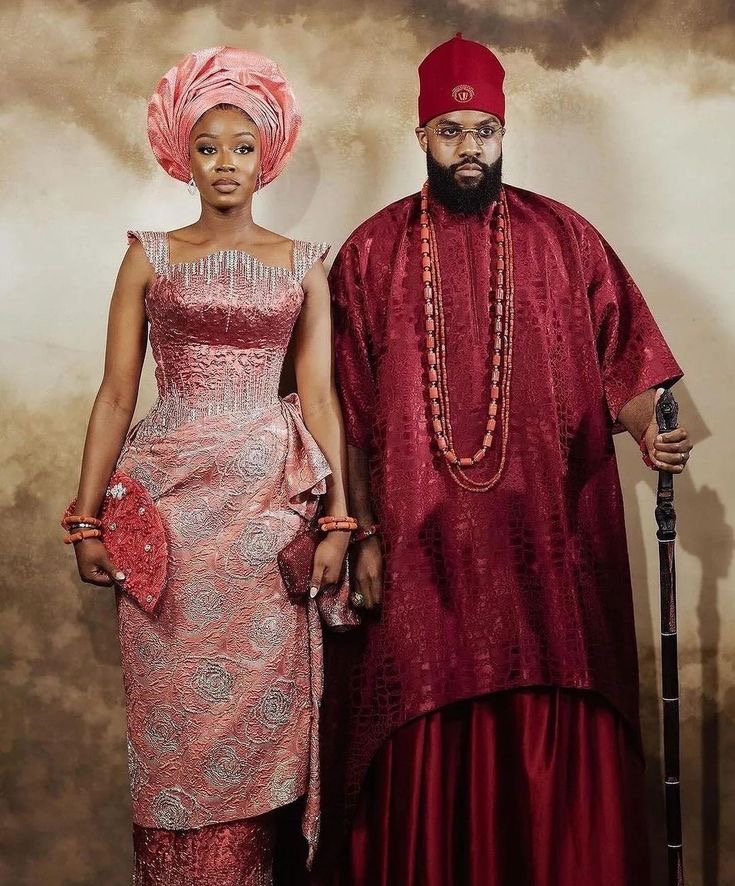Igbo culture is rich and diverse, deeply rooted in traditions, customs, and values that have been passed down through generations. One of the most prominent aspects of Igbo culture is its traditional attire, which reflects the community’s identity and heritage.
Traditional Igbo attire varies by gender and occasion. For men, the “isi agu” is a popular outfit, characterized by its colorful patterns and often worn with a “wrapper” or “buba” (a loose-fitting shirt). Accessories like the “red cap” (often called “okpu agu”) are also significant, symbolizing status and identity within the community.
For women, traditional attire typically includes the “blouse” and “wrapper,” often made from brightly colored fabrics with intricate designs. The “gele,” a head tie, is also an essential part of women’s fashion, showcasing elegance and cultural pride. Jewelry, such as beads and traditional bangles, further enhances the beauty of the attire.
These traditional garments are often worn during cultural festivals, weddings, and significant ceremonies, serving as a means of expressing cultural pride and unity among the Igbo people. The attire not only reflects individual identity but also the shared heritage of the community, reinforcing the importance of cultural traditions in shaping community identity.
Igbo traditional attire is worn on various significant occasions, each reflecting the rich cultural heritage of the Igbo people. Here are some specific occasions:
1. Weddings: Traditional weddings are vibrant celebrations where both the bride and groom wear beautifully crafted traditional attire. The bride often wears a colorful wrapper and blouse, along with a gele, while the groom typically dons an isi agu and a wrapper.
2. Naming Ceremonies: This is a ceremony held to formally name a newborn. Families often dress in traditional attire to celebrate this important milestone, showcasing their cultural identity.
3. Cultural Festivals: Events like the New Yam Festival (Iwa ji ohu) and other local festivals see participants dressed in traditional attire, celebrating harvests and cultural heritage.
4. Burials and Memorials: During funerals and memorial services, traditional attire is worn as a sign of respect and to honor the deceased. The colors and styles may vary based on the family’s customs.
5. Community Gatherings: Various community events, meetings, and gatherings often encourage traditional attire, reinforcing cultural ties and unity among participants.
These occasions highlight the significance of traditional attire in expressing cultural identity and preserving Igbo heritage.

An Igbo attire for a man and a woman
Igbo attire during and before the colonial era was rich in cultural significance and varied widely based on factors such as gender, age, and social status.
Before colonial influence, the traditional attire of the Igbo people was primarily made from locally sourced materials. Men typically wore a wrapper known as “isi agu” or “agbada,” which was a large piece of cloth wrapped around the waist, often accompanied by a shirt. They adorned themselves with accessories such as beads, caps, and sometimes animal skins, which signified their status and achievements. Women wore a “wrapper” or “gele,” which is a piece of cloth wrapped around the waist, paired with a blouse. Their attire was often colorful and intricately designed, reflecting their creativity and the local culture.
During the colonial era, the introduction of Western clothing began to influence Igbo attire. While many Igbo people adopted Western styles, traditional garments remained significant, especially during ceremonies and cultural events. The red cap, for instance, became a symbol of authority and respect among titled men, reinforcing the importance of traditional attire in maintaining cultural identity despite external influences.
The red cap, often referred to as “isi owu” in Igbo culture, holds significant importance and symbolism. Here are some key aspects of its significance:
1. Authority and Leadership: The red cap is traditionally worn by titled men in the Igbo community, symbolizing their status and authority. It signifies that the wearer has undergone the necessary rites to earn respect and recognition within the society.
2. Cultural Identity: Wearing the red cap is a way for individuals to express their cultural identity and pride in Igbo heritage. It connects the wearer to their roots and the traditions of their ancestors.
3. Mark of Respect: The red cap is also a sign of respect in various social gatherings and ceremonies. It indicates that the wearer is a person of honor and has a significant role within the community.
4.Symbol of Wisdom: In many instances, the red cap is associated with wisdom and experience. It is often worn by elders and respected figures in the community, highlighting their roles as advisors and leaders.
Overall, the red cap is a powerful emblem of status, respect, and cultural pride in Igbo society, deeply intertwined with the values and traditions of the people.
In conclusion, Igbo attire has evolved but continues to play a vital role in expressing cultural heritage and identity, balancing traditional practices with modern influences.

This is beautiful, can you do more of this please?
I love this
Keep soaring higher Bby ❤️